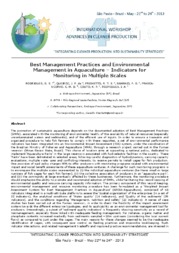Best management practices and environmental management in aquaculture: indicators for monitoring in multiple scales.
Best management practices and environmental management in aquaculture: indicators for monitoring in multiple scales.
Author(s): RODRIGUES, G. S.; QUEIROZ, J. F. de; FRIGHETTO, R. T. S.; SAMPAIO, F. G.; FRASCÁ-SCORVO, C. M. D.; COUTO, K. R.; RODRIGUES, I. A.
Summary: Abstract: The promotion of sustainable aquaculture depends on the documented adoption of Best Management Practices (BMPs), associated with the monitoring of environmental health, of the availability of natural resources (especially uncontaminated waters and sediments), and of the efficient use of inputs. In order to ensure a traceable and organized procedure to help fish farmers to comply with these requisites, a set of environmental performance indicators has been integrated into an Environmental Impact Assessment (EIA) system, under the coordination of the Brazilian Ministry of Fisheries and Aquaculture (MPA), through a research project carried out in the Furnas reservoir (Minas Gerais State, Brazil). This choice of location aims at supporting a national policy, dedicated to implement ?Aquaculture Parks? in the large reservoirs associated with hydroelectric facilities in the country. These ?Parks? have been delimitated in selected areas, following careful diagnostics of hydrodynamics, carrying capacity evaluations, multiple water uses and conflicting interests, to receive permits to install cages for fish production. One provision of said policy charges MPA to offer producers with monitoring programs related with environmental impact and social benefit assessments of these aquaculture ventures. A challenge for such monitoring programs is to encompass the multiple scales represented by (i) the individual aquaculture ventures (be these small or large numbers of fish cages for each fish farmer), (ii) the collective association of producers in an ?aquaculture park?, and (iii) the community at large eventually affected by these businesses. Furthermore, the monitoring procedure should emphasize the ability to promote and recommend adoption of BMPs, while facilitating the record keeping of environmental quality and resource carrying capacity information. The primary component of this record keeping, environmental management and resource monitoring procedure has been formulated as a ?Weighted Impact Assessment System for Best Management Practices in Aquaculture? (APOIA-Aquaculture), comprised of 68 indicators integrated in a multi-attribute platform to assess the ?Spatial organization? of the enterprises (in a set of 22 indicators), the analytical conditions of ?Water quality? (14 indicators), and ?Quality of the sediments? (09 indicators), and the conditions regarding ?Management, nutrition and safety? (23 indicators). A series of case studies has been carried out at the Furnas reservoir, in order to check the flexibility of the impact assessment system towards the different enterprise typologies, and its applicability as an environmental management tool for producers. Interestingly, a subset of ?sediment quality indicators? is frequently showing sensitivity as a record of mismanagement, especially those linked with inadequate feeding management. For instance, organic matter and phosphate contents increased markedly from sediments sampled ~10m upstream (considering the local current lows) as compared to just under the cages. The main reasons for these changes seemed to be the inadequate identification of cages, with consequent poor control on feeding practices and impossible bookkeeping. Such indicator interactions, and related management tradeoffs and improved practice recommendations, are stressed in 4th International Workshop
Publication year: 2013
Types of publication: Paper in annals and proceedings
Unit: Embrapa Environment
Observation
Some of Embrapa's publications are published as ePub files. To read them, use or download one of the following free software options to your computer or mobile device. Android: Google Play Books; IOS: iBooks; Windows and Linux: Calibre.
Access other publications
Access the Agricultural Research Database (BDPA) to consult Embrapa's full library collection and records.
Visit Embrapa Bookstore to purchase books and other publications sold by Embrapa.

